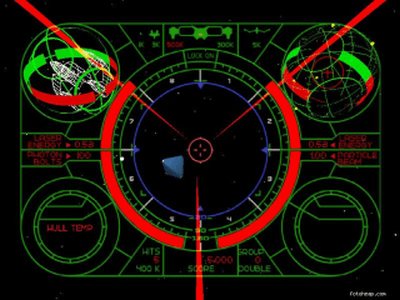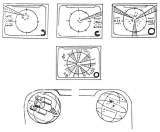

The Last Starfighter © 1984 Atari.
An alien entrepreneur has placed Starfighter games machines on Earth as a test for prospective Starfighters. Although Starfighter appears to be another arcade game, it contacts the alien when the high score record is broken.
Alex, a 19-year old who lives in a trailer park, is an ace at Starfighter and gets whisked off to the planet Rylos as a draftee to combat the evil Xur and the Ko-Dan armada. Having been fooled into coming, Alex refuses and is returned to Earth. While Alex is gone from Rylos, a Ko-Dan attack destroys all the Gunstar ships (Starfighters) and crews, except for a prototype equipped with a special weapons system called Death Blossom.
Alexis, meanwhile, changes his mind and, with the help of the alien, returns to Rylos where, with Navigator/Pilot Grigg, he takes off in the last Gunstar to take on the whole enemy fleet. Fighting through a series of space battles, Alex and Grigg succees in saving the universe and then return to earth to pick up Alex's girlfriend before assuming the role of commander of Rylos armed forces and being given the hero treatment on Rylos.
BASIC GAMEPLAY:
Player controls weapons on Gunstar and orientation of Gunstar chair; he is not piloting ship. Player's head-up display shows information on weapons system and coolant (shields), as well as on currently targeted enemy, surrounding enemy positions and Gunstar chair orientation. Not all information is available in each round.
Each of the enemy ships takes a different amount of energy to destroy. Enemy condition is shown by the 'Target temperature gauge'. When the enemy temperature hits max, it will explode. The rate at which the gauge rises is determined by the type of ship. Temperature rises while player's lasers are contacting enemy ship and may fall if this ceases before destruction.
The condition of the Gunstar is shown by the 'Hull temperature gauge'. When the Gunstar is being hit by the enemy fire, the hull temperature increases. When the hull temperature gets high, coolant flows in (around the gauge on screen from the on-screen reservoir) to coll the hull. This depletes the reservoir of coolant. If no coolant remains, the hull temperature will reach maximum and the Gunstar is destroyed. A coolant recharge is given at the end of a complete round.
LASERS:
Player's laser energy is shown for each side laser. Laser energy decreases with time of laser use and increases far more slowly. This encourages short bursts of fire from one laser at a time. If both lasers are fired simultaneously, a third laser also fires from below without additional depletion of energy, but with additional effect on the target. This contradictorily encourages use of both lasers simultaneously. As players increase in skill, they will learn to use shot, single laser bursts on small targets and twin laser bursts on large targets. This combination will ensure best energy usage and maximum destructive effect. It is possible for a player to be stranded with inadequate energy and be destroyed of insufficient ability to retaliate, but this cannot happen on beginner rounds where energy drain is very low.
Death Blossom (laser blossom) is fired with rear buttons on Star Wars controller. The central circle will light up on screen to show when Death Blossom is charged and usable. Activation causes the screen to be blanketed with laser fire destroying (or greatly heating up if mother ship) all targets on screen. Does not destroy Control Tower and Xur's transport.

Atari System IV hardware
CPU: Motorola 68000, TMS32010
In 1984, there was a movie called 'The Last Starfigter' (TLSF). It was a Sci-fi adventure movie. It was the first movie ever to be made were all the special effects (except explosions and make up) were made on a computer. The computer was a Cray X-MP. This and the fact that space movies were very popular in this time made everyone expecting this movie to be a big blockbuster like Star Wars. This is why Atari bought the rights for the movie so they would be able to make a game based on it. It was going to be released on both home consoles and in arcades. The arcade game was never finished.
The production of the game started in Atari's arcade division. The original project team was made up of Chris J. Horseman (Project leader), Jim Morris (Project engineer (software)), Jack Ritter (2nd project engineer (software))
and Barry Whitebook (Animation). Ted Michon and Mike Albaugh came onboard this project later in development. Prior to this game, 3-D arcade games used only vector graphics. Atari had for several years worked on a general purpose 3-D arcade system, but it was always 'a few years away' every time they wanted to use it (an arcade game called "I, Robot" was actually released in 1984, and this game had solid 3-D polygons, but it was hard coded and was very different from TLSF; this was actually the first game developed by Atari to be programmed with C). This is where Ted Michon comes into the picture. Ted worked as a consultant for Atari and developed a super high, bit-mapped system with a polygon-filling engine. Atari decided to use this to on the TLSF arcade. They also had to use the system's expanding capabilities to implement a math box that could handle the 3-D transformations. The programming of the math box was done by Jack Ritter.
Programming for the arcade game was done mainly by Jim Morris. The additional programming with the cave sequence on the game was done by Jack Ritter. Jack came onboard from Cinematronics.
In the programming process Jim used a Motorola 68000 CPU, the first to ever be used at Atari. The programming language was C. They also used several 3-D tools that were later used in other games. TLSF became a pioneer in using the 68000 CPU. Back then, most games were made with the 6502 CPU. The arcade games "Hard Drivin" (1989) and "Stun Runner" (1989) have a very similar graphics engine with TLSF game, even though another graphic engine was used with those games.
The gameplay in the game was taken right from the gameplay in the movie and scenes from the movie; this was often done with spinoff games like this. The game was actually very similar with what was seen in the movie, at least regarding the graphics. The controller for the game was a controller from the "Star Wars" vector games that Atari made. When Atari chose to drop the game, it was about 75% finished. There was no cabinet for the game, but the game worked and it could be played on a test bench. They also made some simple sound effects for the game.
There were several reasons behind Atari's decision to cancel the game so far into production. Atari had for some years paid a lot of money to the movie companies for the rights to produce licensed tie-in games, with themes taken from the movies. This cost Atari a lot of money over a long time. Atari gambled on the movie to become the success that everyone predicted, but this did not happen. The film didn’t fail, but it wasn't a success either. In the production of the arcade they found out that the machine would have a selling price of 10,000$, and this was a lot of money back in the 80's. If the movie had been a big success this price could have been defended. The vice president of Atari thought that no one would buy a game for 10,000$. Not long after that, the project team got the message that the game was cancelled. At the same time, Atari was in deep financial problems caused by Atari's consumer division. On top of all this came the big video game crash. The result was that Atari started to fall and fall, until it closed down in the end. The original arcade division of Atari was shutdown in 2001 when Midway chose to shutdown Midway West (Midway had bought Atari Games (Atari`s arcade division) and changed its name to Midway West). Prior to this Atari had been sold to a couple of other companies, and they frequently changed leaders. But Atari never became the company it was prior to the crash. Some years after Atari cancelled TLSF, the arcade game Hard Drivin' was released. This game sold for the same price that TLSF had (10,000$).

| Ships destroyed increases score by ship value, multiplied by a distance bonus; i.e., if an expert can hit a ship while distant, he will receive more points than a novice who hits when close. | |
| Each round ship scores increases. |
Hitting two ships at one scores 4 times the single ship value.
Project leader : Chris Horseman
Project Engineer (Software) : Jim Morris
3-D Hardware : Ted Michon
Math Box Programming : Jack Ritter, Mike Albaugh
Animator: Barry Whitebook
Machine's picture.
Håkon Galstad information
Game's ROM.